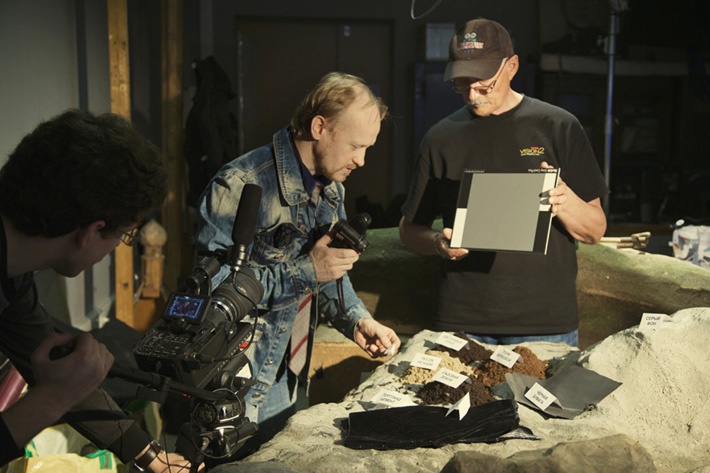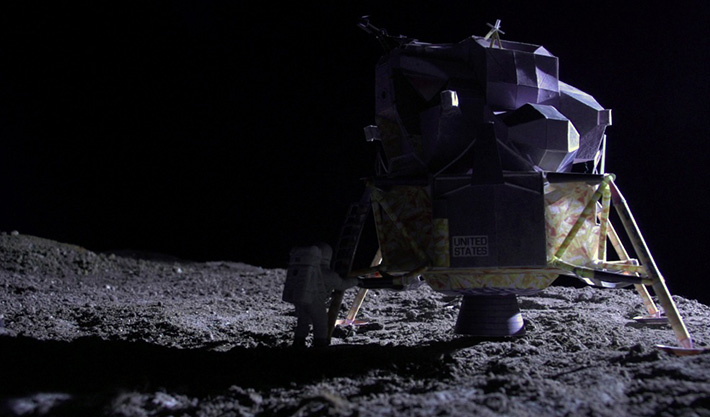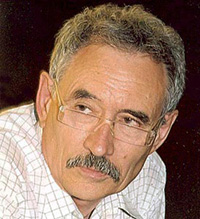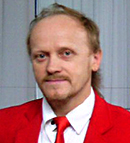MythBusters episode 104 Exposed
Aldrin descending the ladder is re-analysed by professional Cinematographers in Russia
Was the landing by US astronauts on the Moon a hoax? Did NASA fabricate the Apollo record? Did Neil Armstrong take his first steps in a studio? These questions were addressed in the US show MythBusters, episode 104, 2008 season. During the programme a photograph of an Apollo 11 astronaut in the shadow of the lunar module (LM) was examined.

Apollo skeptics claim that additional lighting was used in this scene. The astronaut can be seen clearly, despite the fact that he is in the shadow of the lunar module. There is only one light source on the Moon – the Sun. Apollo skeptics also state that there must be another source of light, which accounts for the astronaut being so well illuminated. Can the sunlight reflected from the lunar surface illuminate the astronaut to such an extent?
To investigate this question MythBusters recreated, in a studio, similar conditions to those on the lunar surface. A single source of light, surface material that reflects 8% of the light, and a model astronaut on the shadow side of the LM. (Who was incorrectly named Armstrong, but of course it was actually Aldrin descending the ladder).
Needless to say, the conclusion reached by MythBusters was that the light reflected from the lunar surface was indeed enough to get such a well-exposed shot of the astronaut.
But when verification of this conclusion was undertaken by two Russian cinematographers Yuri Elkhov and Leonid Konovalov by recreating the shooting conditions as on the “Moon”, but in a studio, they reached a completely different result. The model astronaut standing in the shadow was very dark, not as in the NASA photo of Aldrin. Moreover, two cinematographers found that the mythbusters [must have] resorted to fraud. Initially the "mythbusters" got a negative result, but they then [allegedly] falsified the actual shooting conditions, and re-shot everything.
Here is part of Episode 104 of the TV series MythBusters (2008 season):
Editor's note: MythBusters say: "Our astronaut is clearly visible" – but in fact it is still not as brightly lit as the NASA photo.
The two cinematographers, Yuri Elkhov and Leonid Konovalov, decided to repeat the mythbusters' experiment and verify whether the reflected from the lunar surface light can actually illuminate the astronaut to such an extent as in NASA's well known picture sequence.

First, to simulate the lunar regolith, soil samples with different reflectivity were selected. A standard grayscale diffusely reflects 18% of light:


18% river sand; 3% garden soil; 4% black paper; 7% upper peat
The Moon has light areas, which are called highlands, where albedo of the lunar surface is 12-13%, and there are dark areas, the so-called maria.
According to the Apollo 11 record astronauts landed at the Sea of Tranquility, where the albedo is 7-8%.
The soil in the bucket approximately corresponds to the reflection coefficient of the lunar regolith; it is 2 times darker than the standard grayscale.

The surface is sprinkled with "regolith".

The walls of the studio are draped in black velvet.

There are still a few light sources including the ceiling lights.


And fluorescent lamps on the ceiling.

A scale model of the LM is set up in the correct orientation – with the ladder in full shadow. The upper lights are not yet turned off.

Now all the overhead lights are off and the only source of light remains the one simulating sunlight. This is how the model astronaut appears in this light:

The image can be artificially lightened. So this was done, but in a way that preserves the "regolith" texture:

According to NASA the snapshot of the astronaut in shadow of the lunar module was taken on 70mm reversal Kodak color film (ISO 160) by a medium format Hasselblad camera. A medium format camera was used for this exercise, virtually the same design as the Hasselblad, and photographed on Kodak color film ISO 100.
This is the camera with a detachable film magazine:

To prevent the photographer's face and clothes from acting as a reflective or additional source of light, the photographer wore black gloves and a black gown (which reflect 3-4% of the light). But how else could the shot be taken?

This is the result:

The results were examined in detail.

The model astronaut’s boots are completely dark. There is no light that can hit such a low point. The upper part of the helmet is also in darkness. A helmet cannot be lit from above by anything. We see reflected light on PLSS and on his legs. This is reflected light from the illuminated "lunar" surface behind him.

And now observe the difference!

– Click to enlarge
The horizon of the NASA photograph is correctly aligned:

It is not clear what the astronaut was actually doing. Is he supposed to be ascending or descending the ladder? Why was he leaning at a 45 degree angle? Was it possible to descend the ladder in such a fashion? Maybe he had been standing for a photographer for a long time, got tired of waiting, resting his knees against the ladder?
So from where did so much light emanate in NASA's picture? This video answers this question, just half a minute (best viewed in HD):
Editor's note: Please ensure captions are 'on' to view the English translation
Finally here are the two pictures for comparison – the astronaut in the shadow of the lunar module with one light source, and a frame with the model astronaut illuminated from the camera position with a powerful source of diffuse light.

Left image: With a single light source. Right image: Additional illumination from a position near the camera – Click to enlarge
The conclusion reached is unambiguous. NASA's photo is a fake. This picture cannot have been taken on the Moon but in a studio with a very strong additional source of illumination from near the camera.
Yuri Elkhov and Leonid Konovalov
Aulis Online, July 2012
English translation from the Russian by BigPhil
Note: due to the large size of the images this article is not optimised for viewing on cell phones
See also: Extra lighting used on the Moon
About the Authors
|
Yuri Elkhov was born in 1940 in Moscow. He is a Soviet and Belarusian cinematographer, film director, screenwriter, actor, and a member of the Guild of Russian Film Makers.
In 1970 he graduated from the Camera Department of All-Russian State University of Cinematography (VGIK). He lives and works in Minsk and he is an Honoured Artist of Republic of Belarus. He shot 28 movies, among them such successful and loved by public movies as The Adventures of Pinocchio and About Little Red Riding Hood.
Leonid Konovalov graduated with honours from the Camera Department of VGIK in 1987. Currently he is an Associate Professor of the Camera Department of the Russian State University of Cinematography. He was a camera operator or an additional camera operator on many films and series. He was camera operator on the movie The Belovs which received the State Award in 1994.
He engineered the non-standard photographic films RETRO and DS-50 at the Shostka Chemical Plant "Svema" which were used in the production of 14 movies. In the magazine "Cinema and Television Technology" (in Russian) Leonid has published seven articles in scientific and technical topics. He also has written the book How to Make Sense of Films.
AULIS Online – Different Thinking



